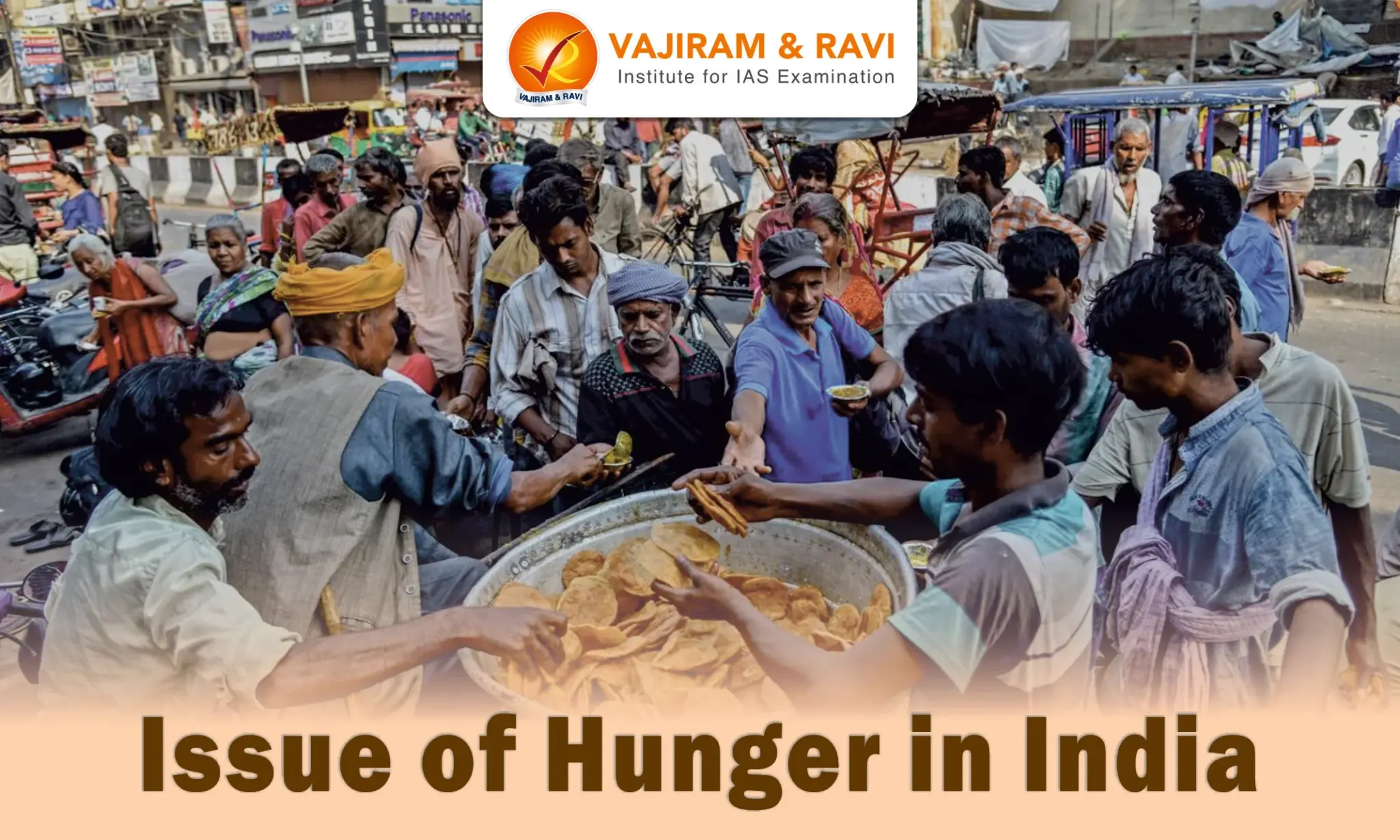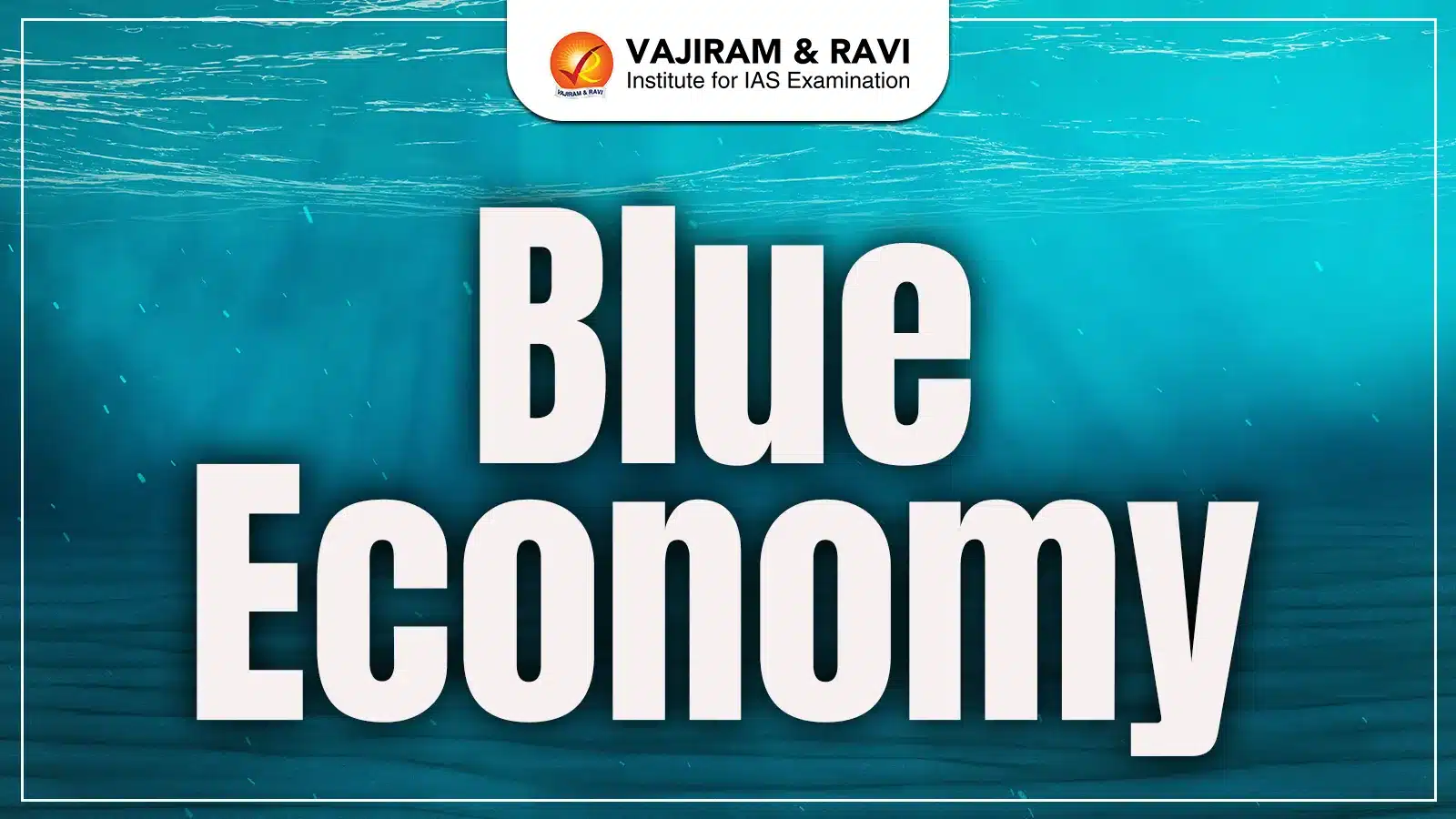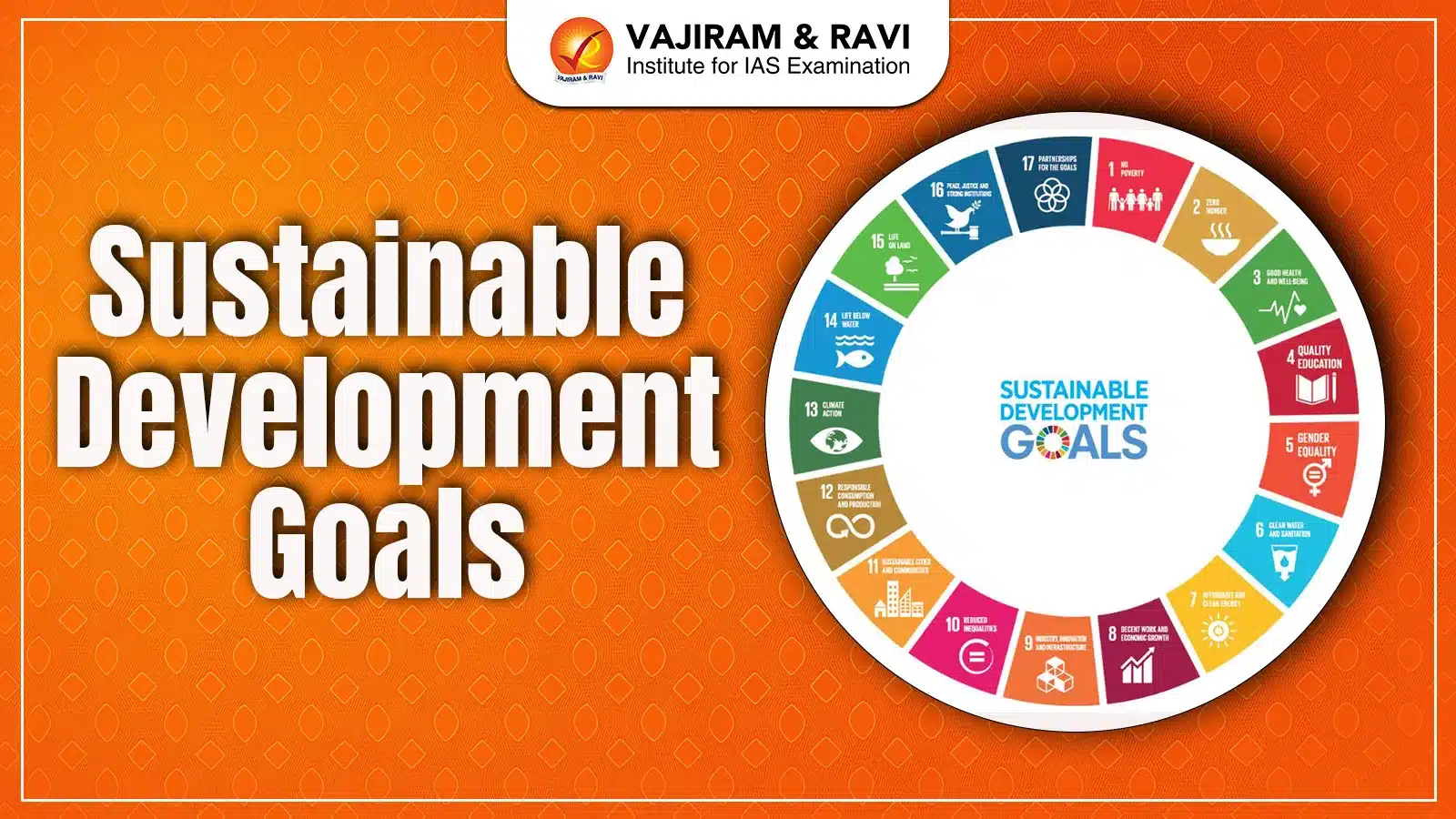What is hunger?
The Food and Agriculture Organization (FAO) defines hunger as the habitual (or chronic) consumption of too few calories to provide the minimum dietary energy an individual requires to live a healthy and productive life. It is an uncomfortable or painful physical sensation caused by insufficient consumption of dietary energy. It is one of the significant manifestations of poverty.
| Acute hunger |
|
| Chronic hunger |
|
| Hidden hunger |
|
What is food insecurity and how is it linked to hunger?
- Food insecurity refers to the lack of access to sufficient, safe, and nutritious food that meets an individual’s dietary needs and preferences, resulting in inadequate or uncertain food intake.
- FAO measures food insecurity using the Food Insecurity Experience Scale (FIES).
- Food insecurity and hunger are closely related concepts. Food insecurity can lead to hunger, as individuals may not have enough food to meet their basic energy and nutrient needs.
- Addressing food insecurity is essential in tackling hunger, as ensuring access to sufficient and nutritious food can help to prevent malnutrition and other health problems associated with hunger.
What is malnutrition, and what are its manifestations?
Malnutrition refers to a condition in which the body is not receiving adequate nutrients, either in quantity or quality, to maintain proper health and functioning.
Various manifestations of malnutrition includes:
- Protein hunger: This is the most common type of malnutrition, which occurs when the body does not get enough protein to meet its energy needs.
- It can result in stunted growth, delayed development, weakened immune system, and other health problems.
- Micronutrient deficiencies: This type of malnutrition occurs when the body does not get enough essential vitamins and minerals, such as iron, iodine, vitamin A, and zinc.
- This can lead to anemia, blindness, impaired immune function, and other health problems.
- Overnutrition: Overnutrition occurs when the body takes in too many calories, leading to obesity and related health problems, such as heart disease, diabetes, etc.
- Undernutrition (caloric deficiency): Undernutrition occurs when the body does not receive enough nutrients due to insufficient food intake or malabsorption, leading to a range of health problems, including weight loss, weakness, and nutrient deficiencies.
What are the various indicators used to measure hunger?
Global Hunger Index
- The Global Hunger Index (GHI) is a tool designed to comprehensively measure and track hunger and undernutrition at global, regional, and national levels.
- The 4 Indicators of GHI are
| Indicator | Description |
| Undernourishment |
|
| Child stunting |
|
| Child wasting |
|
| Child mortality |
|
- GHI 2022: Global hunger, with a score of 18.2, is categorized as moderate in 2022.
- India and GHI 2022: India ranks 107th out of 121 countries. With a score of 29.1, India has a level of hunger that is serious. In 2021, India was ranked 101 out of 116 countries
- Recommendations: The report recommends that decision-makers must place inclusive local governance, accountability, and the realization of the right to food at the center of food systems transformation.
Other global indicators:
- The State of Food Security and Nutrition in the World (SOFI): Annual report by the FAO, which measures progress towards the United Nations’ Sustainable Development Goal of ending hunger and malnutrition by 2030.
- Indicators: prevalence of undernourishment, stunting, and wasting.
- SOFI 2022: India has high undernourishment (about 16% of the population), wasting (about 17%), stunting (about 31%), and low exclusive breastfeeding practice (only 58%)
- The Global Food Security Index (GFSI): is an annual report by The Economist Intelligence Unit, which measures the food security of 113 countries.
- Food Insecurity Experience Scale (FIES): It is developed by FAO and measures the level of food insecurity experienced by households over the past 12 months.
What are the causes of hunger in India?
Some of the major causes of hunger are
- Poverty: Hunger is a consequence of poverty. Poor living conditions and limited food access lead to malnutrition in children, especially in rural areas with overpopulation.
- Gender inequality: Girls suffer more due to the patriarchal mindset, as they are considered secondary and are generally the last to eat in poor families. They are also deprived of mid-day meals due to a lack of access to schools.
- Poor governance: Corruption is one of the greatest obstacles to eliminating hunger. This problem is compounded by the lack of awareness among the people.
- Example: Food distribution is inconsistent, with grains being diverted to the open market for profit and poor quality grains sold in ration shops.
- Unidentified hunger: Inaccurate classification of households as above or below the poverty line, coupled with poor quality grains, leads to a decline in food consumption.
- Hidden hunger: Micronutrient deficiency, caused by poor diet, disease, and inadequate nutrition during pregnancy and lactation, leads to hidden hunger.
- Lack of maternal knowledge: Inadequate understanding of nutrition, breastfeeding, and parenting among mothers is another area of concern.
- Resource wastage and climate change: The consequences of resource wastage are borne by lower strata of society as they cannot adapt to changing events.
- Further, the expansion of deserts, soil erosion, water scarcity, and extreme weather phenomena as a result of climate change invariably affects poor people more, leading to hunger.
- Natural disasters: Weather extremes lead to hunger crises. Droughts and floods destroy harvests and leave the poor vulnerable.
What are the consequences of the prevalence of hunger in India?
Hunger in India has several consequences, both immediate and long-term. Some of the consequences of hunger in India are
- Malnutrition: Hunger leads to inadequate intake of essential nutrients, which can cause malnutrition, stunting, and wasting among children and adults.
- Malnutrition can lead to impaired physical and cognitive development, weakened immune system, and higher risk of diseases.
- Health problems: Hunger can lead to several health problems such as anemia, low birth weight, micronutrient deficiencies, and other diet-related diseases like diabetes and cardiovascular diseases.
- Poverty: Hunger can lead to poverty, as people may not be able to work and earn an income due to a lack of food and energy.
- Hunger also increases health care costs and reduces productivity, which can perpetuate poverty and inequality.
- Education: Hunger also affects education, as children who suffer from hunger are more likely to miss school, have poor concentration, and drop out of school.
- Social unrest: Hunger can lead to social unrest and conflict, as people may resort to violence to obtain food or other basic needs.
What are the various government initiatives to tackle hunger in India?
The twin problems of hunger and poverty pose a serious challenge to the effective advancement of the nation. As a result, the government has been taking many steps to deal with these problems. Some of the steps taken are:
- National Nutrition Mission (NNM), Poshan Abhiyan – NNM was started in 2018 by the Ministry of Women and Child Development to reduce the level of under-nutrition and also enhance the nutritional status of children in the country.
- National Food Security Act, 2013: The Act legally entitles up to 75% of the rural population and 50% of the urban population to receive subsidized food grains under Targeted Public Distribution System.
- Eat Right India Movement: An outreach activity organized by the Food Safety and Standards Authority of India (FSSAI) for citizens to nudge them towards eating right.
- Zero Hunger Program: Launched in October 2017, it aims at eliminating hunger and malnutrition by 2030.
- It aims to intervene on farms by organizing nutrition-focused farming systems, providing zero hunger training, and establishing biofortified plant genetic gardens.
- Pradhan Mantri Matru Vandana Yojana (PMMVY): PMMVY is a Centrally Sponsored DBT scheme with a cash incentive of ₹ 5000/- being provided directly in the bank/post office account of Pregnant Women and Lactating Mothers.
- Pradhan Mantri Poshan Shakti Nirman scheme (PM Poshan Scheme): It is a school meal programme designed with the aim of improving the nutritional status of school-age children across the nation.
What steps can pave the way for the elimination of hunger in India?
Reducing hunger in India requires a multi-faceted approach that involves addressing the root causes of hunger and malnutrition. Some potential ways forward are:
- Addressing poverty: Improving economic conditions and reducing poverty levels through job creation and better access to education.
- Improving public distribution systems: Strengthening the public distribution system to ensure that food is distributed equitably and efficiently.
- Increasing agricultural productivity: Enhancing agricultural productivity through better irrigation, improved seeds, and better technology can help increase food production and availability.
- Promoting dietary diversity: Encouraging the consumption of a more diverse range of foods, particularly fruits, vegetables, and protein-rich foods.
- Focusing on maternal and child health: Improving maternal and child health by promoting breastfeeding, adequate nutrition, and immunization.
- Addressing gender inequality: Reducing gender inequality and promoting education for girls can help improve their nutrition and reduce malnutrition.
- Strengthening monitoring and evaluation systems: Establishing effective monitoring and evaluation mechanisms to ensure that nutritional programs are effective and efficiently implemented.
Last updated on May, 2025
→ UPSC Notification 2025 was released on 22nd January 2025. x
→ UPSC Prelims Question Paper 2025 and Unofficial Prelims Answer Key 2025 are available now.
→ UPSC Calendar 2026 is released on 15th May, 2025.
→ The UPSC Vacancy 2025 were released 1129, out of which 979 were for UPSC CSE and remaining 150 are for UPSC IFoS.
→ UPSC Mains 2025 will be conducted on 22nd August 2025.
→ UPSC Prelims 2026 will be conducted on 24th May, 2026 & UPSC Mains 2026 will be conducted on 21st August 2026.
→ The UPSC Selection Process is of 3 stages-Prelims, Mains and Interview.
→ UPSC Result 2024 is released with latest UPSC Marksheet 2024. Check Now!
→ UPSC Toppers List 2024 is released now. Shakti Dubey is UPSC AIR 1 2024 Topper.
→ Also check Best IAS Coaching in Delhi
Issue of Hunger in India FAQs
Q1. Which regions of India are most affected by hunger?+
Q2. How does climate change impact hunger in India?+
Tags: hunger in india quest


















